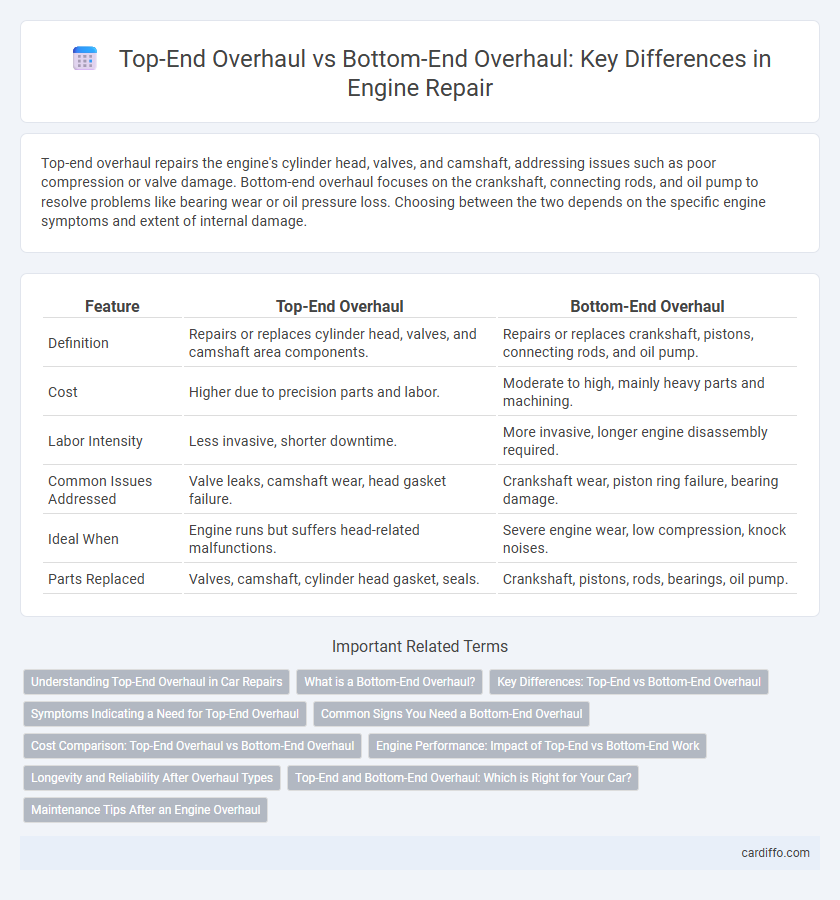Top-end overhaul repairs the engine's cylinder head, valves, and camshaft, addressing issues such as poor compression or valve damage. Bottom-end overhaul focuses on the crankshaft, connecting rods, and oil pump to resolve problems like bearing wear or oil pressure loss. Choosing between the two depends on the specific engine symptoms and extent of internal damage.
Table of Comparison
| Feature | Top-End Overhaul | Bottom-End Overhaul |
|---|---|---|
| Definition | Repairs or replaces cylinder head, valves, and camshaft area components. | Repairs or replaces crankshaft, pistons, connecting rods, and oil pump. |
| Cost | Higher due to precision parts and labor. | Moderate to high, mainly heavy parts and machining. |
| Labor Intensity | Less invasive, shorter downtime. | More invasive, longer engine disassembly required. |
| Common Issues Addressed | Valve leaks, camshaft wear, head gasket failure. | Crankshaft wear, piston ring failure, bearing damage. |
| Ideal When | Engine runs but suffers head-related malfunctions. | Severe engine wear, low compression, knock noises. |
| Parts Replaced | Valves, camshaft, cylinder head gasket, seals. | Crankshaft, pistons, rods, bearings, oil pump. |
Understanding Top-End Overhaul in Car Repairs
Top-end overhaul in car repairs involves servicing components such as the cylinder head, valves, camshaft, and piston rings to restore engine performance and efficiency. Unlike bottom-end overhaul, which focuses on the crankshaft, bearings, and engine block, top-end overhaul addresses issues related to compression, valve timing, and combustion. Proper top-end maintenance enhances fuel efficiency, reduces emissions, and prevents potential engine damage by ensuring optimal air and fuel mixture control.
What is a Bottom-End Overhaul?
A bottom-end overhaul involves repairing or replacing the engine's lower components such as the crankshaft, connecting rods, pistons, and bearings, which are critical for the engine's foundational structure and performance. This type of overhaul addresses issues like worn bearings, damaged pistons, or crankshaft wear that can affect engine compression and oil pressure. Unlike a top-end overhaul that focuses on cylinder heads and valves, a bottom-end overhaul ensures the engine's core mechanical integrity and longevity.
Key Differences: Top-End vs Bottom-End Overhaul
Top-end overhaul involves servicing the cylinder head, valves, and camshaft to restore engine compression and performance, while bottom-end overhaul focuses on the crankshaft, connecting rods, pistons, and main bearings to address issues related to engine rotation and power transmission. Key differences include the components serviced and the symptoms they address; top-end overhaul targets poor engine compression, misfires, or valve problems, whereas bottom-end overhaul addresses knocking noises, low oil pressure, and severe engine wear. Choosing between these overhauls depends on diagnostic findings and the engine's specific mechanical needs.
Symptoms Indicating a Need for Top-End Overhaul
Symptoms indicating a need for a top-end overhaul include frequent spark plug fouling, excessive oil consumption, and noticeable loss of engine power. Engine misfires, rough idling, and compression test results revealing low cylinder pressure also signal top-end wear. Persistent overheating and visible damage to the cylinder head components often confirm the necessity for this repair.
Common Signs You Need a Bottom-End Overhaul
Common signs requiring a bottom-end overhaul include persistent knocking noises from the engine, excessive smoke from the exhaust, and significant oil consumption or low oil pressure. These symptoms often indicate worn crankshaft bearings, damaged pistons, or compromised cylinder walls. Timely bottom-end overhaul is crucial to restore engine reliability and prevent further catastrophic damage.
Cost Comparison: Top-End Overhaul vs Bottom-End Overhaul
Top-end overhauls generally incur higher costs due to the complexity of repairing or replacing components like the cylinder head, valves, and camshaft, which require specialized tools and expertise. Bottom-end overhauls typically cost less because they focus on parts such as the crankshaft, bearings, and oil pump, involving more straightforward mechanical work. Understanding these cost differences helps in budgeting for engine repairs based on the specific damage and required level of restoration.
Engine Performance: Impact of Top-End vs Bottom-End Work
Top-end overhauls concentrate on the cylinder head, valves, and cams, directly improving airflow, combustion efficiency, and overall engine responsiveness. Bottom-end overhauls address the crankshaft, bearings, and pistons, enhancing engine durability, strength, and smooth power delivery. Both types of overhauls significantly influence engine performance but target different components critical to optimal operation and longevity.
Longevity and Reliability After Overhaul Types
Top-end overhaul targets components like cylinder heads, valves, and camshafts, significantly enhancing engine performance and fuel efficiency but offering moderate improvements in longevity. Bottom-end overhaul involves rebuilding the crankshaft, bearings, and pistons, resulting in greater durability and reliability by addressing core engine wear and reducing the risk of catastrophic failure. Engines undergoing bottom-end overhauls typically experience extended lifespan and improved structural integrity compared to those receiving only top-end repairs.
Top-End and Bottom-End Overhaul: Which is Right for Your Car?
Top-end overhaul focuses on repairing or replacing components such as the cylinder heads, valves, and camshaft, addressing issues related to compression and engine performance. Bottom-end overhaul involves rebuilding the crankshaft, pistons, bearings, and connecting rods to restore the engine's structural integrity and resolve core mechanical failures. Choosing between top-end and bottom-end overhaul depends on the specific engine symptoms and damage severity, with top-end repairs typically addressing airflow and combustion, while bottom-end overhauls target fundamental engine mechanics.
Maintenance Tips After an Engine Overhaul
After a top-end overhaul, prioritize regular inspection and replacement of spark plugs, valve adjustments, and coolant system checks to maintain optimal engine performance. Following a bottom-end overhaul, focus on timely oil changes using high-quality lubricants, monitoring oil pressure, and ensuring proper crankshaft alignment to prevent premature wear. Adhering to these maintenance tips extends engine longevity and maximizes the benefits of both overhaul types.
top-end overhaul vs bottom-end overhaul Infographic

 cardiffo.com
cardiffo.com